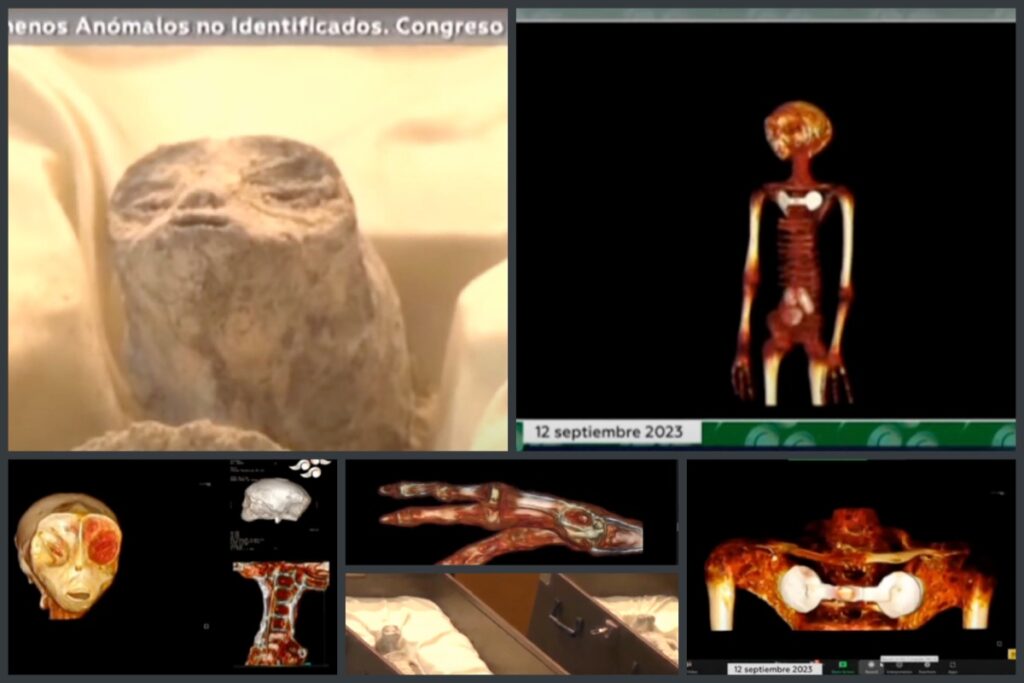Mexico held its first congressional hearing about UFOs and aliens on Tuesday, September 12. During the event, researchers and scientists unveiled alien bodies, accompanied by extensive DNA files, MRIs, and other scans. The presentation has been hotly debated on social media, with many finding the evidence intriguing, and others dismissing it as a hoax. Here is a rundown on the claims made, along with some translations and where you can go to see the DNA files yourself.
To review a comprehensive, in-depth breakdown of all of UFO whistleblower David Grusch’s claims, with citations, see our story here. We’ll be sharing more about UAPs and the alien body investigation in Mexico in our UFO Discord channel, so join us there or subscribe to our emails.
The Presentation Unveiled Extensive Analysis of the Nazca Alien Mummies
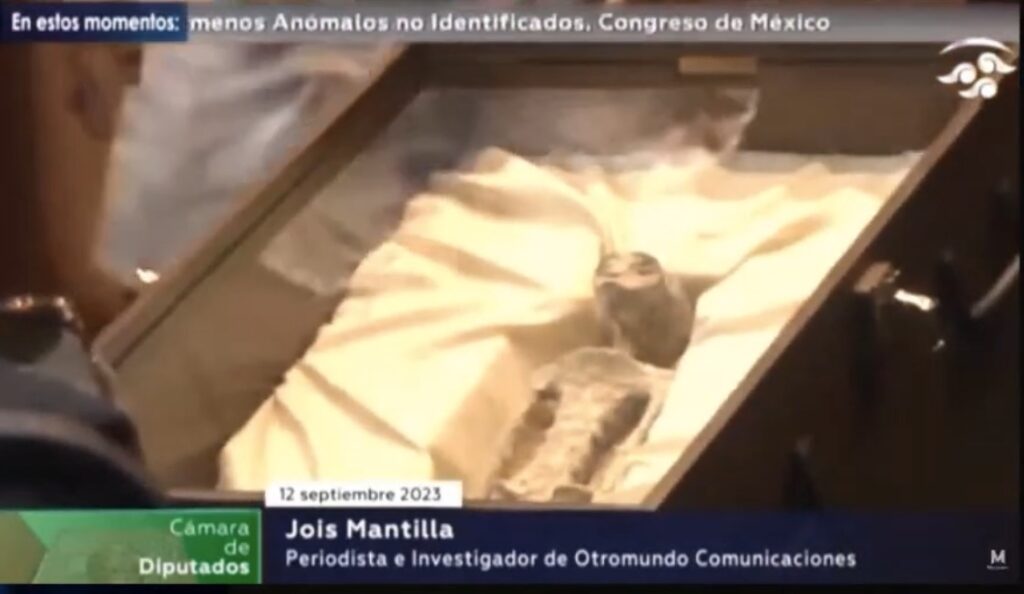
The presentation at the end of the congressional hearing presented comprehensive findings regarding the mummified Nazca aliens found in Peru, along with unveiling two of the bodies for the public to view. You can watch the full video of the alien body presentation, with translations, in the embedded link below. The translation sometimes disappears and isn’t always accurate, so keep that in mind while watching. The part where they reveal the bodies begins around 3:13:20 in the video below. This part of the hearing was moderated by Jaime Mausan.
The presentation lasted for about 50 minutes.
The first presenter for this section of the hearing was journalist and investigator Jois Mantilla. Mantilla noted near the beginning of his speech that people who had debunked the Nazca aliens previously had not actually come to view them in person or did any evidence gathering themselves.
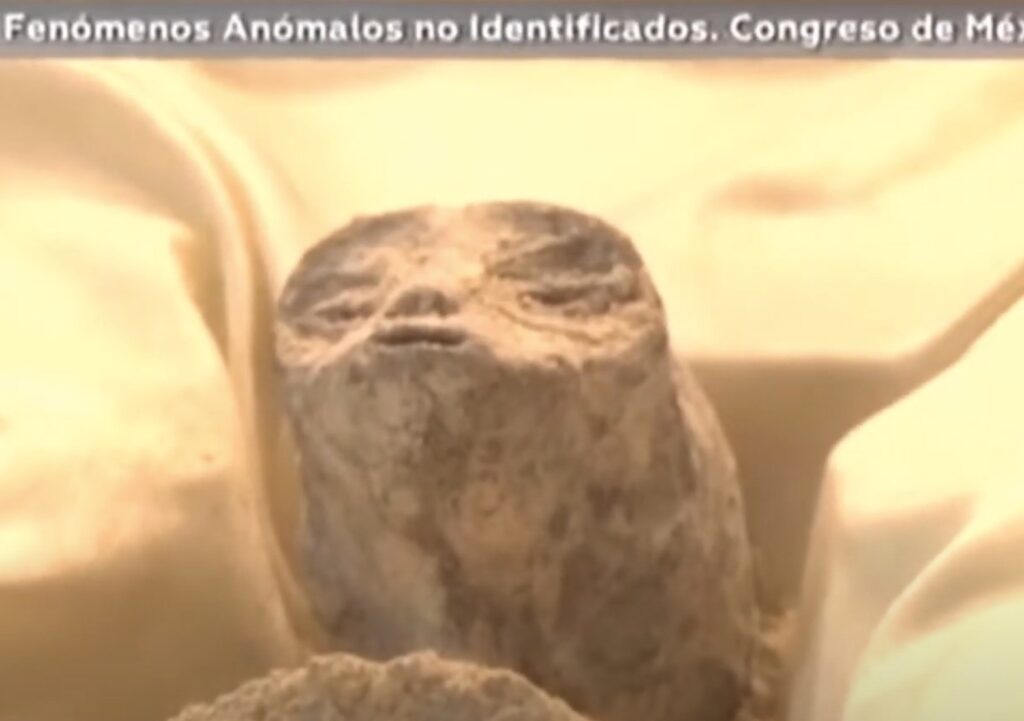
He did acknowledge that the 20 bodies (two of which were shown during the presentation) were discovered during an illegal dig with no archeologists present, but he said that shouldn’t be enough to dismiss the findings.
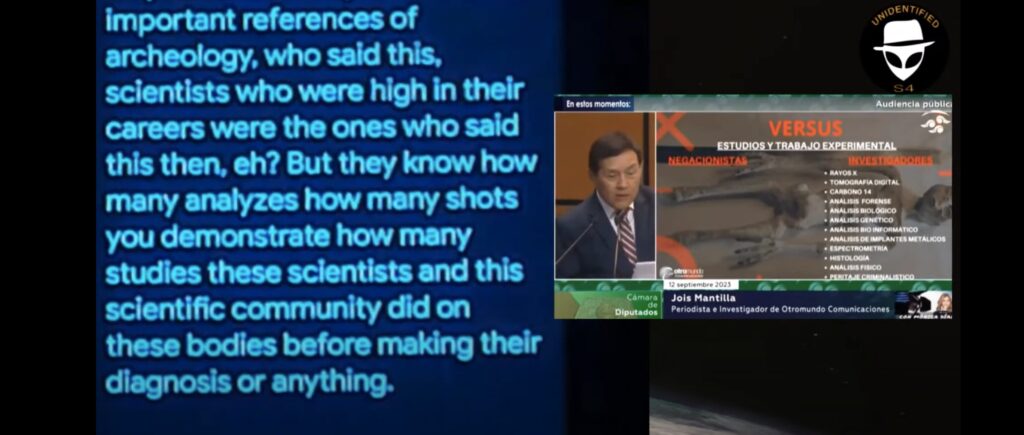
The alien bodies were found in 2015, near the famous Nazca Lines.
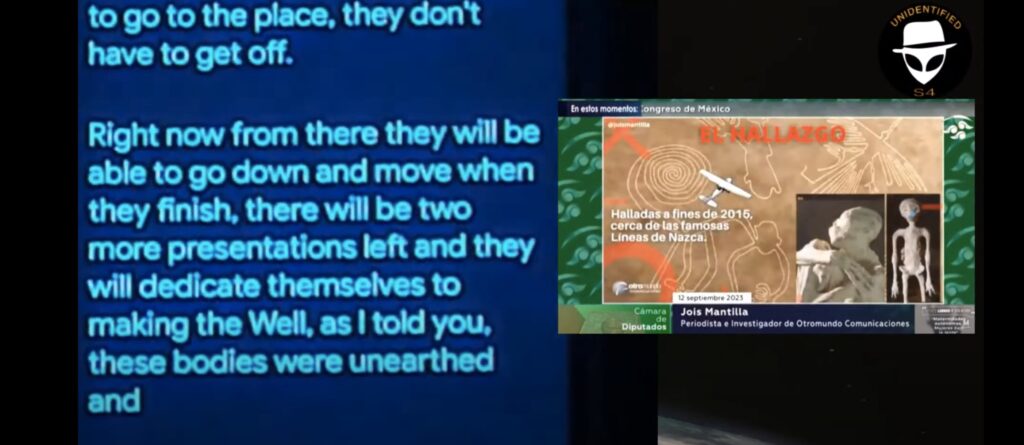
The bodies, one slide noted, were not human and had only three fingers on each hand. They were estimated to be from 700 to 1,800 years old.
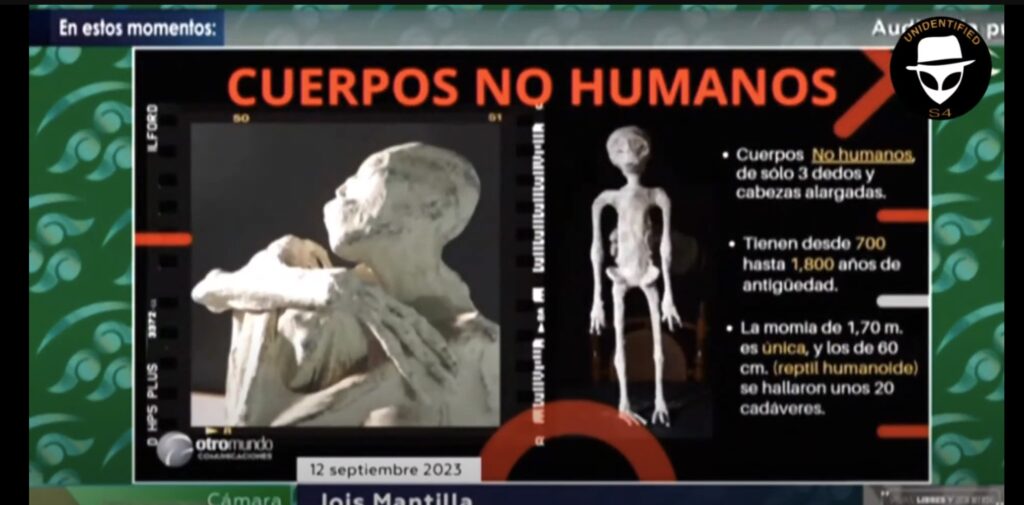
Some of the bodies also had what appeared to be small ritualistic “replications” about 15 to 20 centimeters in height accompanying them, possibly in tribute to them.
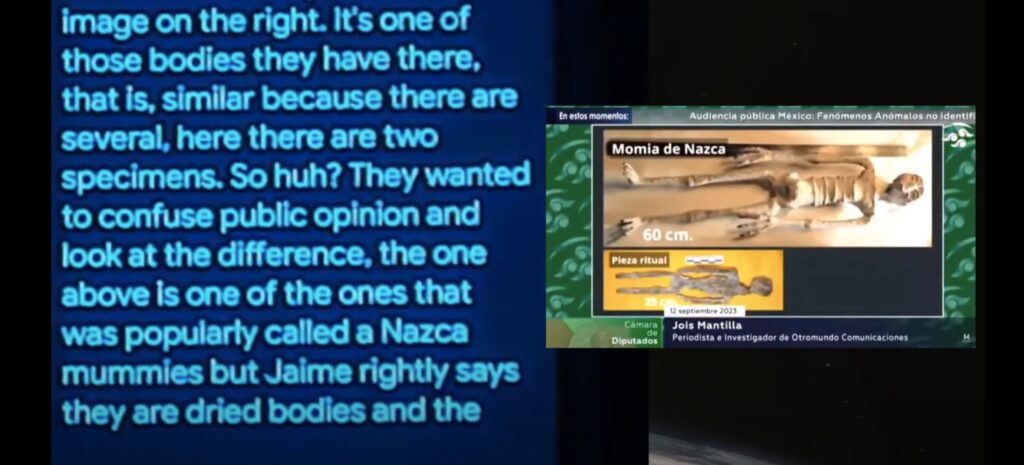
Two researchers had tentatively labeled one of the bodies as a humanoid reptile because of its characteristics, and found that all the cells from different parts of the body matched.

Mantilla shared a slide of companies that had helped with the analysis of the specimens (whose logos are in the screenshot above.) Among them were:
- Instituto de Fisica
- Ingemmet
- San Luis Gonzaga
- Genetech
- Harrisburg University
- St. Petersburg University
- UNAM
- Lakehead University
- Cen4gen
- Abraxas
- BETA Radiocarbon Dating (Beta Analytic)
- BioTecMol
In his presentation, Mantilla noted that evidence indicated there were two different species among the 20 bodies, and their DNA analysis did not match any known species on Earth.
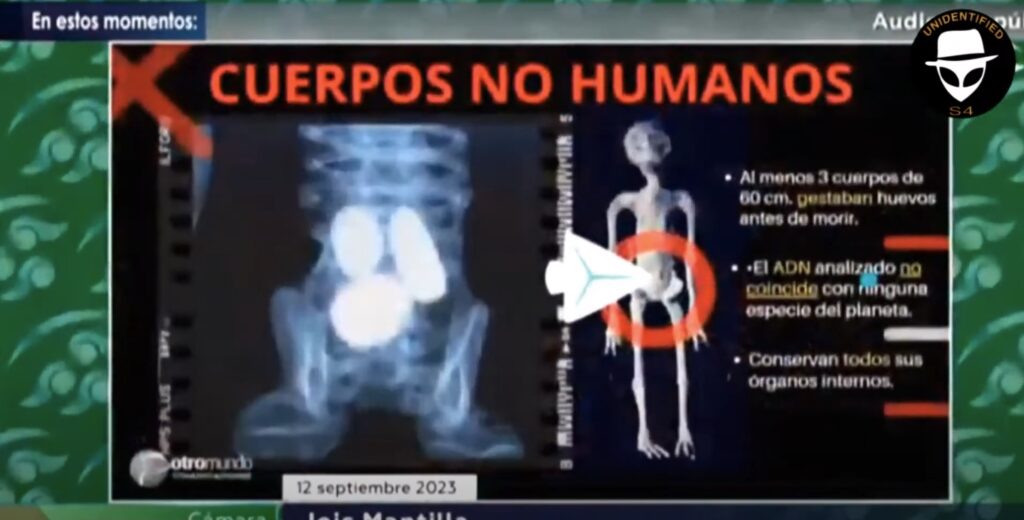
He shared that at least three of the bodies had fertilized eggs inside, and all the internal organs had been conserved due to a highly effective preservation method that utilized, in part, diotamaceous earth. One of the bodies, he said, showed evidence of a three-week-old embryo.
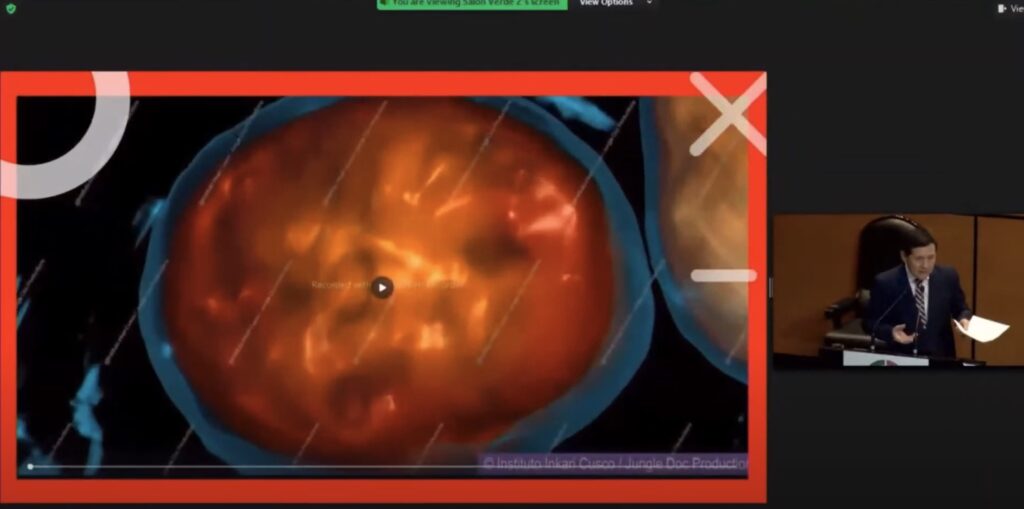
Here are some more screenshots from the part where he discussed the embryo:
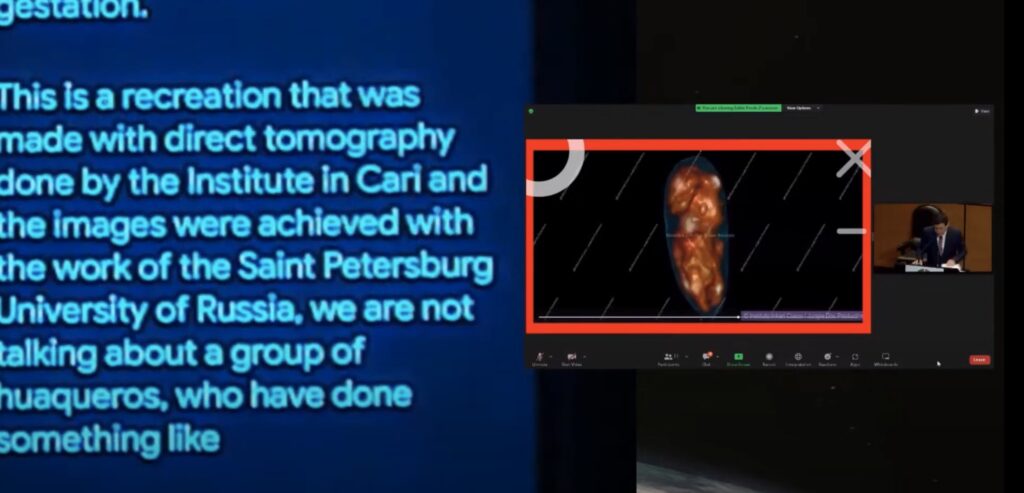
And this slide compares the embryo to a human embryo:
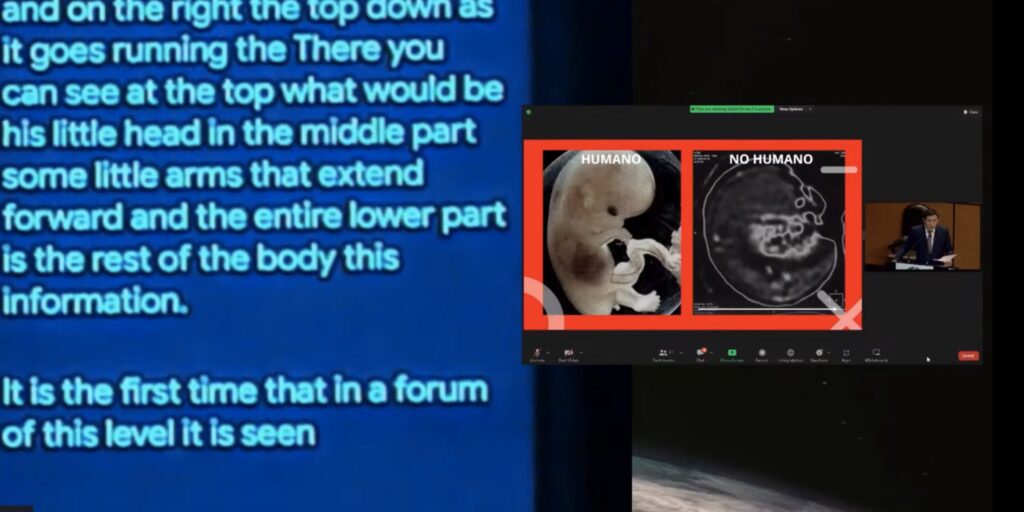
Near the end of his presentation, he noted that the bodies they found resembled antiquated paintings, carvings, and other crafts displaying three-fingered creatures. These have been seen in Peru, Mexico, Chile, Cuba, Argentina, Venezuela, and other locations around the world, which might indicate a cultural overlap with humanity.
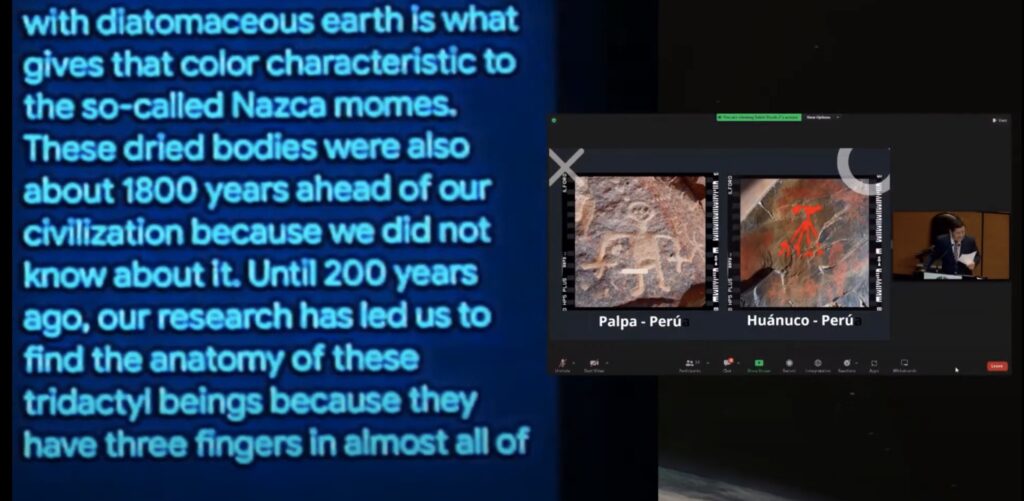
Below are a series of slides he showed of the different cultural artifcats with similarities to the alien bodies:
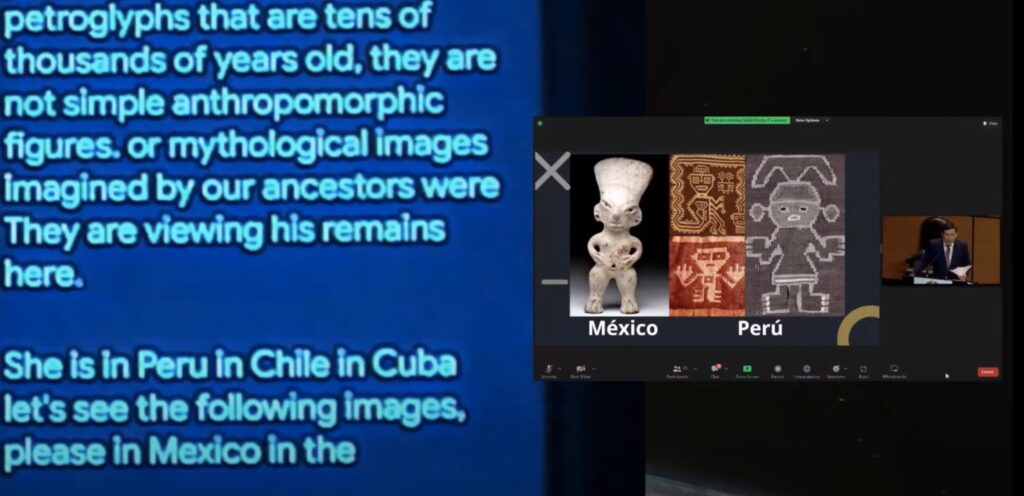
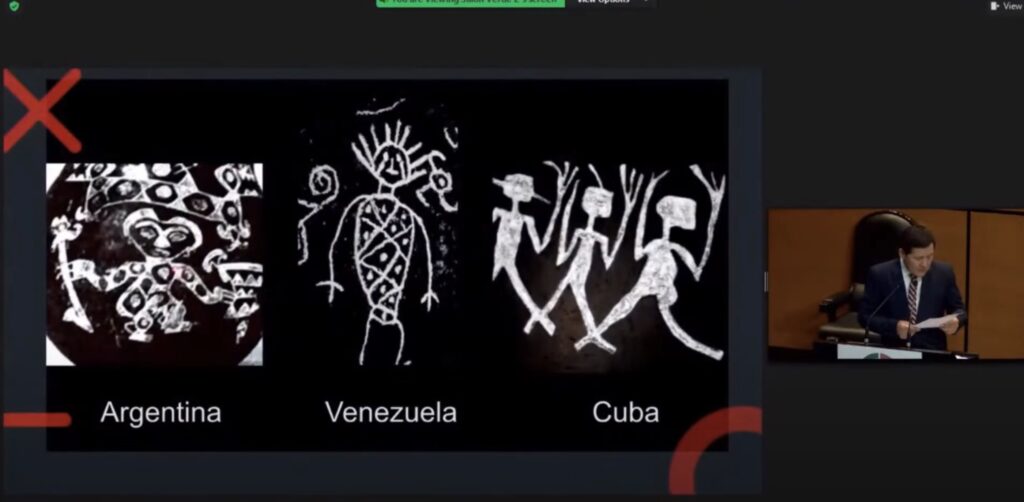
The bodies were in such pristine condition because they had been preserved using diatomaceous earth and other materials that helped keep them intact.
DNA Evidence Is Posted Online for Anyone to View
Mantilla noted that the genetic information they had compiled about the bodies has been uploaded online and anyone who wants is welcome to analyze it.
The links to the DNA evidence posted online can be found here:
- https://ncbi.nlm.nih.gov/sra/PRJNA869134
- https://ncbi.nlm.nih.gov/sra/PRJNA865375
- https://ncbi.nlm.nih.gov/sra/PRJNA861322
The Unidentified DNA Doesn’t Definitively Indicate They’re Aliens, But Does Leave Open the Possibility
In a Reddit discussion about the DNA findings, one reader noted the samples were contaminated somewhat due to age and how the remains were handled, so some terrestrial and human DNA got mixed in. The unknown portion that doesn’t match anything in the database is the intriguing part.
In a separate discussion, another Redditor who is a biotechnician wrote: “One taxonomic analysis showed a 70% UNIDENTIFIABLE ancestry with ANY existing form of life DNA or RNA (virus), nor with any ancestral earth species or form of genetic data! That means… the genetic data of one specimen had 70% of genetic DNA unrecognizable to anything that scientists have ever sequenced. Holy CRAP. Alien? Not necessarily. Weird, unheard of species, almost related to nothing on Earth? Most definitely.”
Another Redditor, u/ch1c0p0110, said they are a biologist and wanted to provide more insight on how the DNA web links work.
They wrote a lengthy comment that reads, in part: “The links links provided are to the NCBI’s SRA (Short Read Archive). Short reads correspond to the the raw sequencing data from NGS (Next Generation Sequencing) techniques, which are are then filtered using some post sequencing quality control and go through several downstream steps and pipelines before before being used in any kind of analyzes… First, you take a tissue sample. Maybe it is a biopsy… Then you break the cells and extract DNA using mechanical and/or chemical methods… For Illumina sequencing (the technique we are dealing with here), you the break all the DNA, which is usually in very long strands (thousands to millions of base pairs long) into smaller ~300 baes pairs long. These smaller DNA pieces are then sequenced, and in the case of this particular sample, they are Paired-end sequenced, leaving us with 2×150 base pair reads. This sequenced reads can then be assembled into longer DNA strands, either de-novo or using a reference genome.”
They went on to note that we’re dealing with ancient DNA (aDNA) that’s at least 1,000 years old. A taxonomy read of 60% unidentifiable doesn’t mean it’s definitely alien, but simply indicates that it doesn’t match anything in the database. It also doesn’t rule out aliens, but there is still a lot to learn.
Benitez Said the DNA Was Compared with 1 Million Known Species & Had a 30% Difference from Humans, While Humans Have a 15% Difference from Bacteria
During the forensic scientist Dr. Jose de Jesus Zalce Benitez’s presentation (which is shared in more detail later in this story), he also discussed the DNA findings.
Benitez said, via a translation: “I will point out that the DNA analysis, after having been compared with more than 1 million registered species, we found that there is a significant difference between what is known and these bodies. These studies were carried out in various high-level institutions, both national and international, and the results gave evidence that 70% of the genetic material coincides with what is known, but there is a difference of 30%.”
Benitez added: “What is the relevance of this? Well, if the human being, compared to primates, has a differentiation of less than 5% and compared to bacteria, it has a differentiation of less than 15%, this would indicate that the difference found of more than 30% is something totally outside the parameter and of what expected, is foreign to what is described and known at this moment by human beings.”
A Bioinformatics Subreddit Is Challenging Readers to Analyze the Data
The reactions on Reddit to the DNA portion of the hearing were intriguing.
Redditor r/stackered, who said they work in genomics, wrote: “Just to let you know there is no way ChatGPT can analyse this, its too much data. I’ll have to pay to launch a large instance on AWS and run the analysis all day tomorrow. That’s why perhaps someone who has access to a large supercomputer on that sub might be able to do it cheaply.”
Stackered was so interested that they started a thread in Bioinformatics inviting anyone who wanted to review the uploaded files and comment on them. You can read the thread here. Stackered note in their challenge that the scientists hadn’t published a paper on their findings yet, and noted: “If this were an alien, I don’t think we’d necessarily be able to sequence their DNA unless they are of terrestrial origin. It would mean they have the same type of DNA as us. Perhaps they were our forefathers from a billion years ago and everything we know about evolution was wrong. I want to believe. Maybe we are really the aliens.”
Three Bodies Had Metallic Implants
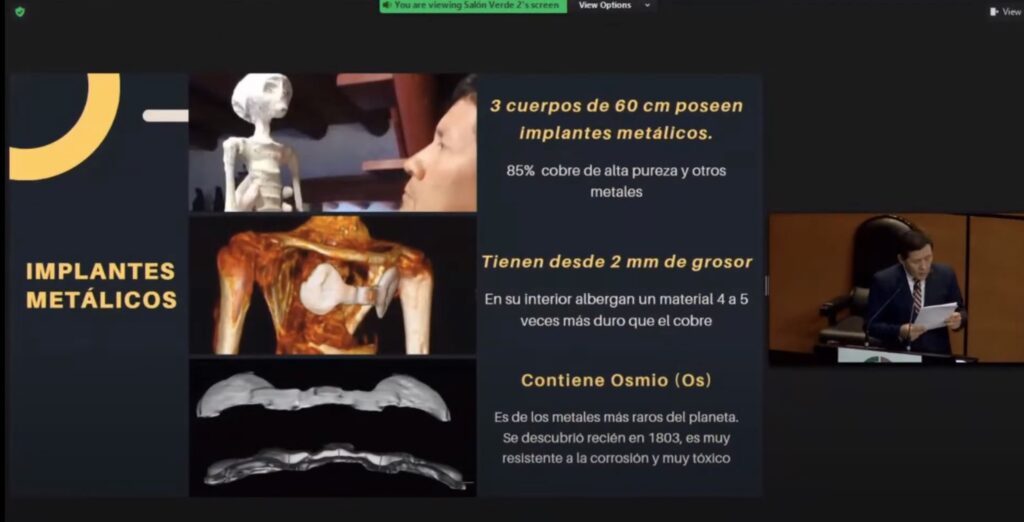
Three of the alien bodies had metallic implants, Mantilla noted. They were covered with an 85% high-purity copper, and the interior was made of a material four or five times stronger than copper. The material also contained osmium, one of the rarest metals on the plant. It’s very toxic and resists corrosion.
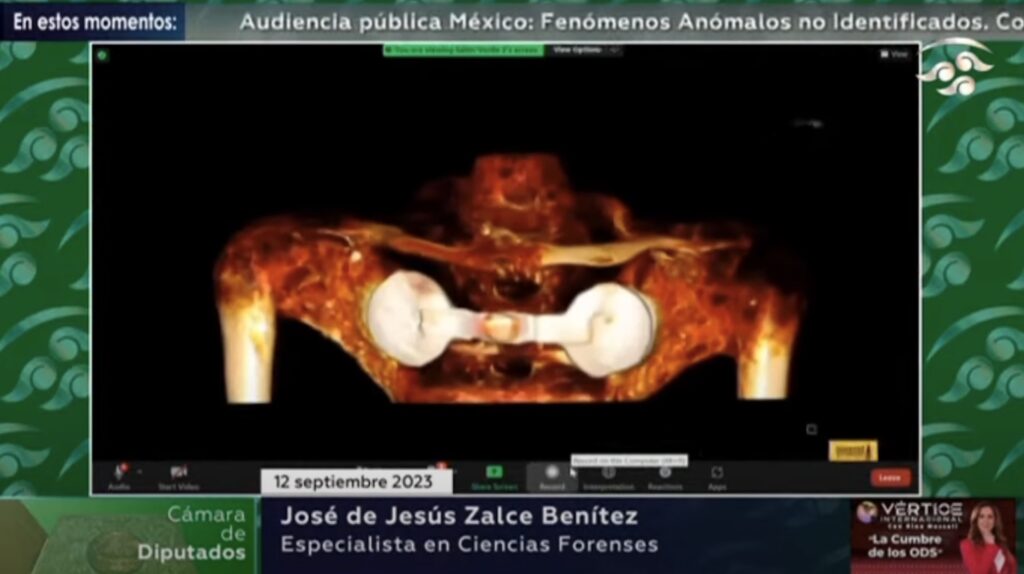
According to Wikipedia, osmium is one of the rarest elements in the Earth’s crust, and the densest naturally occurring element. It’s twice as dense as lead. It was first discovered in 1803 in London, England, along with other elements in the platinum group. Commercially, it’s obtained as a byproduct from nickel and copper mining and processing. It typically isn’t used in its pure state because of the toxicity of its oxide. It’s typically used with other metals in certain applications, such as osmiridium used in fountain pen tips, electrical contacts, and the like because it’s resistant to wear.
Oxmium tetroxide is used in fingerprint detection and electron microscopy. For microscopy, osmium atoms enhance image contrast due to being electron-dense.
Its high reflectivity in the UV range led to its use in space UV spectrometers and osmium-coated mirrors flown in space missions. (However, low orbit oxygen radicals deteriorated osmium layers.)
Full Translation of the Forensic Expert’s Presentation
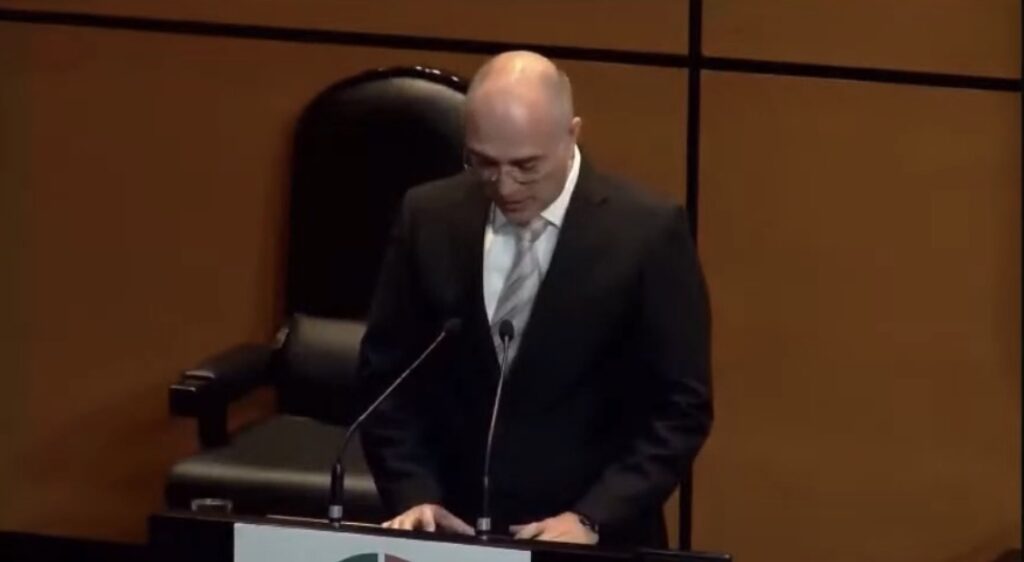
After Mantilla’s presentation, the next presenter was Dr. Jose de Jesus Zalce Benitez, who serves as the director of the Navy’s Scientific Institute for Health. He was also previously the director of the Navy’s Forensic Medical Service and served 30 years in Mexico’s Navy.
Redditor u/Mordrenix provided a translation of Benitez’s presentation, which we are including below.
He said he could confirm the bodies weren’t human
Benitez said: “As a forensic doctor, in collaboration with the biologist Jose de la Cruz Ríos, and based on the results of various scientific evidence, such as X-rays, computed tomography, three-dimensional reconstructions, macroscopic and microscopic analyses, histology, carbon 14, forensic anthropology, comparative anatomy and DNA analysis, which is the queen of evidence in forensic sciences for comparative studies, I can affirm that these bodies are not related to human beings. For this purpose, I will start with the description of the images that we will see next.”
The bodies were conserved through use of diatom powder & dated to be about 1,000 years old
Benitez said: “They are bodies approximately 60 cm long, covered by a white powder that, through electron microscopy, we identify as diatom powder, which allows the desiccation of the bodies as well as the absence of the generation of bacteria, fungi and cadaveric fauna. The presence of this dust allows the perfect conservation by desiccation of these bodies, causing a natural conservation process over time which we were able to calculate by applying the carbon 14 test which indicated and dated an average of 1000 years old. This makes the place where these bodies were found an ideal place for their conservation and preservation by whoever or those who deposited them at this site in Peru.”
The bones and skeletal structure displayed some similarities to birds
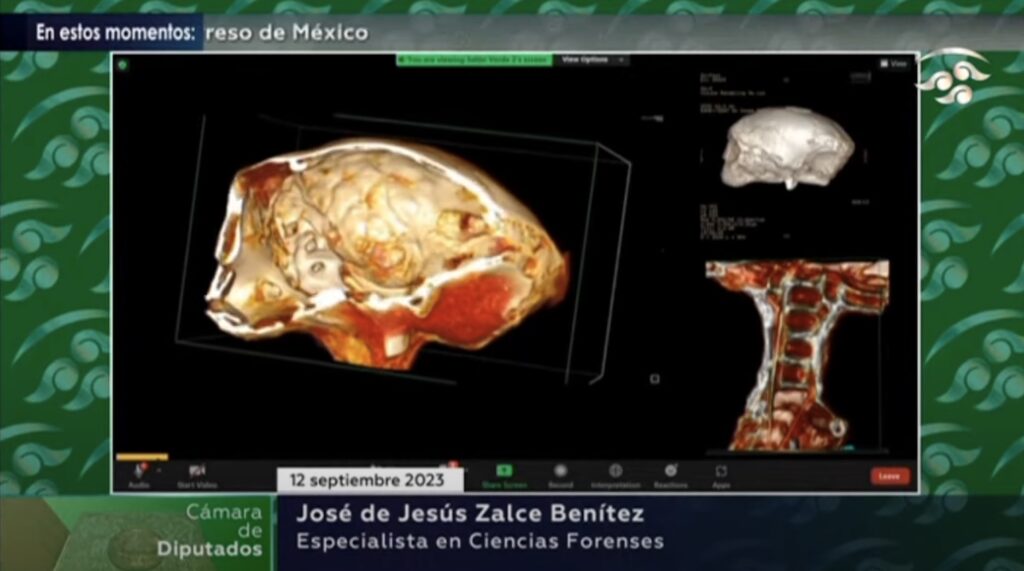
Benitez said: “Entering the topic of anatomy, we can see that they have a humanoid structure that consists of a head, trunk, abdomen and limbs, which end in tridactyl hands and feet. The bone structure of the entire skeleton shows us perfect harmony and agreement between the joints. The final part of each bone fits perfectly with the bone that follows it and the wear of these is also observed due to the movement of the specimen’s own biomechanics, being very resistant bones, but very light, strong, but light like those of the birds.”
He also gave a detailed analysis of the head:
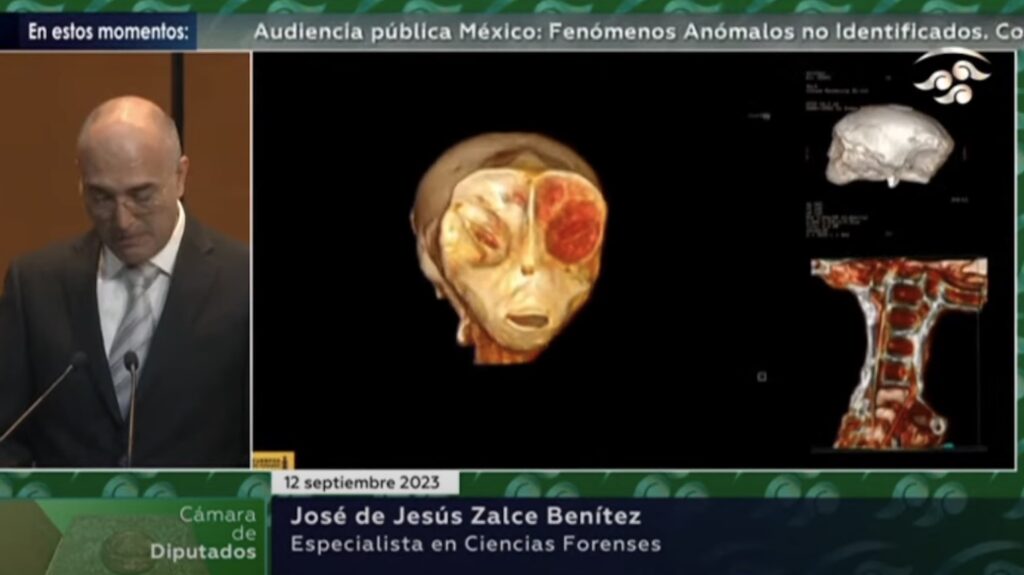
Benitez added: “The head is an element of particular interest since it is large in its proportions compared to the body, however, it is a pneumatized skull, that is, with spaces that allow it to be very light but rigid and resistant, with a large intracranial cavity which evidence that it was a container for very large brain or neurological material. Likewise, we see that the spaces in the eye orbits are very large in size, which would allow a very wide stereoscopic vision for this specimen. It has very small nostrils and an oral cavity that, due to its jaw joint and absence of teeth, allows us to determine that its nutrition was by swallowing and not by chewing.”
Next, he discussed the neck and how it differs from primates.
Benitez said: “The neck, in turn, is a long structure that joins the head in the middle floor of the skull, which is a rarity that does not occur in primate species, since the union is in the posterior floor through the foramen magnum, and not in the middle, which is usually circular or ovoid in shape, being something unique since in these species it is rectangular and cubic in shape. This is consistent with the four or five cervical vertebrae which are small in bone thickness but have a very wide intervertebral disc which makes it possible for this neck to be retractable like that of turtles.”
Benitez said: “In the thorax, we find a fork very similar to that of birds, which allows the shoulder joints to continue and have very wide mobility capabilities. In the thorax we find that the ribs are complete and continuous, completely circular until they join with the vertebral column, they have a very small space between them, being between 14 and 16 in number.”
He also discussed the eggs
Benitez said: “In the abdomen, we can evidence the presence of 3 eggs that, thanks to the tomography, we were able to show at a millimetric level that there are oviducts with the presence of millimetric eggs. This means that they were in a continuous gestation process. In addition, it confirms 100% that they are biological and organic since the process of replication or reproduction through these eggs and their development in the oviduct would be impossible to falsify.”
Benitez added: “We can also observe, thanks to tomography, the traces of muscles, tendons, ligaments and blood vessels, as well as possible organs or organelles that would have to be defined in subsequent studies. Coming to the extremities, we can point out that there is a complete harmony and agreement between the joints and the wear and tear of the biomechanics of the specimen which end in tridactyl hands and feet with 5 phalanges, this would allow them not to occupy the thumb as a position, but rather use your 3 fingers in a wrapping manner to hold things.”
Benitez said: “Here is one of the most outstanding and relevant peculiarities: that they do not have carpal and tarsal bones, the phalanges are direct to the bones of the arm and forearm, in addition to ending in a kind of nail bed for the nail and that observation of microscopes we found fingerprints, this would be impossible to replicate. These fingerprints are of particular interest since most specimens on this planet have deep or circular footprints and the fingerprints of these specimens are completely straight and horizontally linear.”
He discussed the metal implants
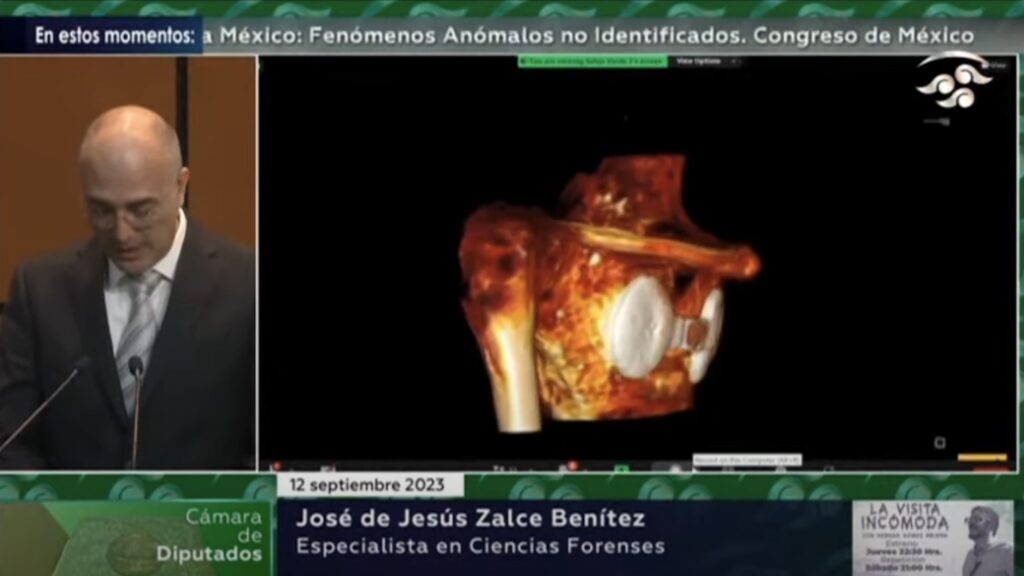
Benitez said: “Another peculiarity is that some of these bodies have metal implants that are perfectly attached within the skin and towards the surface, making a very impressive biofunctional fusion. These implants are the alloy of various metals, among which osmium and cadmium stand out, which are currently used for satellite telecommunications.”
Benitez said: “Finally, I will point out that the DNA analysis, after having been compared with more than 1 million registered species, we found that there is a significant difference between what is known and these bodies. These studies were carried out in various high-level institutions, both national and international, and the results gave evidence that 70% of the genetic material coincides with what is known, but there is a difference of 30%.”
Benitez said: “What is the relevance of this? Well, if the human being, compared to primates, has a differentiation of less than 5% and compared to bacteria, it has a differentiation of less than 15%, this would indicate that the difference found of more than 30% is something totally outside the parameter and of what expected, is foreign to what is described and known at this moment by human beings.”
Benitez said: “These studies and results are published and available to anyone who likes to analyze them or continue them. We accept that there is still much to discover and we are open to the scientific community and the world joining efforts to define what we are facing and how far we can go as a result of collaboration in a scientific and academic study.”
He concluded that the bodies are non-human
Benitez said: “In conclusion and for all the above, we can say that these bodies are from a non-human species that has irrefutable differences with what is described in the biology and taxonomy of the Darwinian species evolution tree, without a common or traceable predecessor or without a descent. and evolution still described. I can affirm then that these bodies are 100% real, organic and biological, that at the time they had life and are irrefutable evidence in themselves. We are facing the paradigm of describing a new species or the opportunity to accept that there has been contact with other non-human beings that were drawn and pointed out in the past in various cultures throughout the world such as Peru, Egypt and Mexico, and that today we can accept their existence among and with us. Thank you very much.”
Dr. Ricardo Rangel Martinez shared some biological findings, including more details about the DNA results as well. However, the translation that YouTube provided for his portion has a lot of mistakes. He talked a bit about each of the specimens, where they were taken from, how they were taken, and the unidentified sequences (also discussed in this section as well.)
The Forensic Scientist Gave a Preliminary Presentation About Some of the Alien Bodies in 2018
It’s worthwhile to note that the forensic scientist also gave a preliminary presentation about some of the alien bodies in 2018 to the Congress of Peru, which you can watch in the embedded video above.
More Studies & Scans, Including Carbon 14 & X-Rays, Were Performed

There is more information to keep in mind from the presentation. The studies they performed (according to a Reddit translation) included:
- X-Ray
- Digital Tomography
- Carbon14
- Forensic Analysis
- Biological Analysis
- Genetic Analysis
- Bioinformatic Analysis
- Metallic Implant Analysis (metallurgy)
- Spectroscopy
- Histology
- Physical Analysis
Some People on Social Media Are Skeptical Due to the History of Some of the Experts, While Others Are Intrigued
Some people on social media have expressed skepticism about the presentation, while others are intrigued. One of the biggest sources of skepticism stems around the background of the presenters, particularly Jaime Maussan and Dr. Jose de Jesus Zalce Benitez.
In 2017, Snopes expressed distrust of Maussan’s original Peru Nazca announcement based on a previous event he was involved with in 2015. According to the article, he led an event called “Be Witness” that unveiled a mummified corpse which he said was an alien, but was later shown to be a human child. Forensic scientist Benitez was a lead researcher of the event. It’s worth noting that although the Snopes article claimed to be debunking the Nazca finding too, it didn’t offer any evidence from the actual bodies to debunk them.
Some of the experts who took part in this research or in the presentation include:
- Raymundo Salas Alfaro – Radiologist from Peru
- Jose de la Cruz Rios Lopez – Biologist from Mexico
- Jose de Jesus Zalce Benitez – Forensic doctor from Mexico
- Galetskiy Dmitriy Vladislavovich – from St. Petersburg University in Russia
- Salvador Angel Romera (Abraxas) – from UNAM with a graduate in genomics
- Ricardo Rangel Martinez – An expert in immunogenetics
- INGEMMET laboratory in Peru analyzed the rock and metal samples
We will add to this article as more translations or details become available.
This work by Stephanie Dwilson is licensed under CC BY-ND 4.0. Please note that this license does not include photos or videos that may be in the story.

